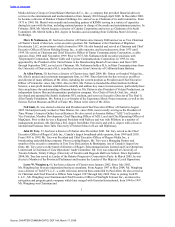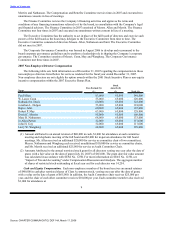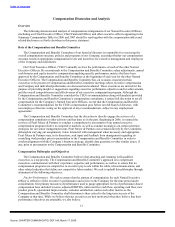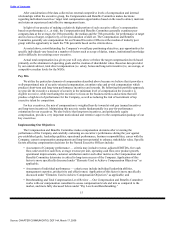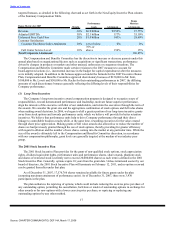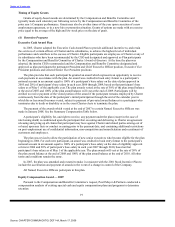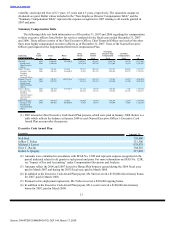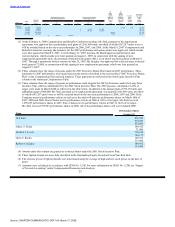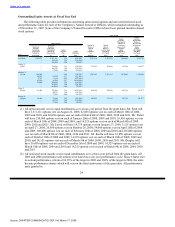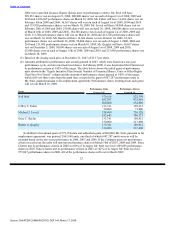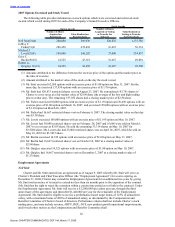Charter 2008 Annual Report Download - page 23
Download and view the complete annual report
Please find page 23 of the 2008 Charter annual report below. You can navigate through the pages in the report by either clicking on the pages listed below, or by using the keyword search tool below to find specific information within the annual report.
Table of Contents
Elements Used to Achieve Compensation Objectives
The main components of the Company’s compensation program include:
• Base Salary — fixed pay that takes into account an individual’s role and responsibilities, experience,
expertise and individual performance designed to provide a base level of compensation security on an
annual basis;
• Executive Bonus Plan — variable performance-based pay designed to reward attainment of annual
business goals, with target award opportunities generally expressed as a percentage of base salary;
• Long-Term Incentives — awards including Stock Options, Performance Units/Shares and Restricted
Shares designed to motivate long-term performance and align executive interests with those of our
shareholders; and
• Special Compensation Programs — cash and equity programs targeted at executives in critical
positions designed to encourage long-term retention.
Details of Each Element
(1) Base salary
Base salaries are set with regard to the level of the position within the Company and the individual’s
current and sustained performance results. The base salary levels for executives, and any changes in those
salary levels, are reviewed each year by the Compensation and Benefits Committee, and such adjustments
may be based on factors such as new roles and/or responsibilities assumed by the executive and the
executive’s significant impact on then current Company goals. Salary adjustments may also be based on
changes in market pay levels for comparable positions in our competitive markets. Base Salaries are reviewed
and adjusted with regard to (a) market competitive Base Salary levels and increases, (b) the employee’s
impact on and contributions to the business performance, and (c) Company-wide total salary increase budgets.
With regard to 2007, the Compensation and Benefits Committee approved the following Base Salary
increases: Mr. Smit received no increase per the terms of his Employment Agreement, Mr. Lovett received a
$31,150 increase, Mr. Fisher received a $15,000 increase, Mr. Quigley received a $20,025 increase, and
Mr. Raclin received a $20,025 increase. However, there is no specific weighting applied to any one factor in
setting the level of salary, and the process ultimately relies on the subjective exercise of the Compensation
and Benefits Committee’s judgment. Although salaries are generally targeted at market median compared to
an industry peer group and to a peer group of comparably leveraged companies (discussed below) and other
compensation survey data for experienced professionals, the Compensation and Benefits Committee may also
take into account historical compensation, potential as a key contributor as well as special recruiting/retention
situations in setting salaries for individual executives above or below the market median. Based upon data
provided by our outside advisor, Base Salaries for our NEOs are, on average at median competitive levels.
(2) Executive Bonus Plan
2007 Executive Bonus Plan
For 2007, bonuses for eligible employees were determined based on Charter’s (or, if applicable, an
employees’ particular division’s or KMA’s) performance during 2007 measured against four performance
goals or measures. These measures, and the percentage of an employee’s bonus allocated to each measure, are
revenue (30%), adjusted EBITDA for corporate employees (excluding corporate marketing) or operating cash
flow for divisional and KMA employees (30%), unlevered free cash Flow (20%) and customer satisfaction
(20%). The percentage allocation for revenue and adjusted EBITDA was changed for 2007 from 2006,
previously 40% for revenue and 20% for adjusted EBITDA to give equal weighting to these measures to
reflect their importance in the operation of the Company. Target bonuses for executive officers ranged from
60% to 125% of base salary in 2007, subject to applicable employment agreements (see “Employment
Agreements”). The range of potential payouts relative to target vary by measure and range from 0% to 200%
of target.
In February 2008, the Compensation and Benefits Committee determined that achievement toward
performance goals for 2007 resulted in bonuses under the 2007 Executive Bonus Plan in the amount of
106.45% of
16
Source: CHARTER COMMUNICATIO, DEF 14A, March 17, 2008



